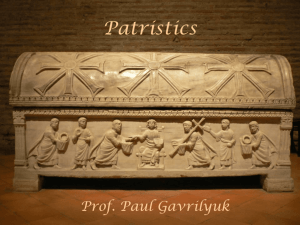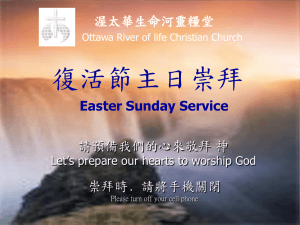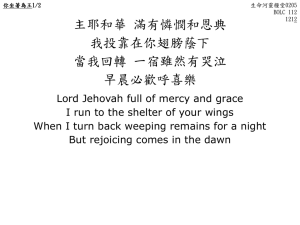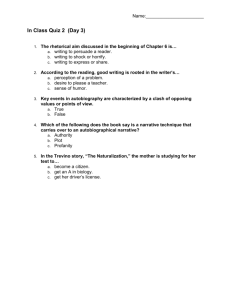Human and Divine Suffering in Late Antiquity
advertisement
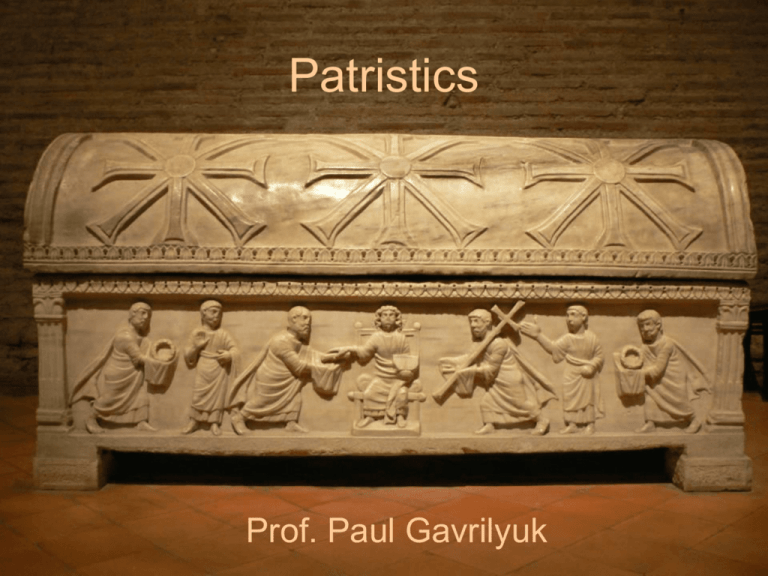
Patristics Prof. Paul Gavrilyuk Introduction 1. A course overview. 2. Course requirements. 3. Methodological reflections. Christ Enthroned. San Vitale, Ravenna. c. 547 AD. Major Questions 1. Hermeneutics. How do we read/ interpret early Christian sources? 2. Context. How is Christian faith related to the Greco-Roman world and early Judaism? 3. Development. How did the main doctrines and practices of the Church develop? Orthodoxy and heresy Continuity and discontinuity Authority Role of scripture Major Doctrinal Themes 1. 2. 3. 4. 5. 6. 7. 8. God. Christ. Trinity. Salvation. Theological Anthropology. Ecclesiology. Eschatology. Biblical Interpretation. The history of dogma is a commentary on one word: “Godman”. Vasily Bolotov (1853-1900) Major Doctrinal Themes 1. 2. 3. 4. 5. 6. 7. 8. God. Christ. Trinity. Salvation. Theological Anthropology. Ecclesiology. Eschatology. Biblical Interpretation. Major Institutions and Practices • • • • • • Bishops Councils Creeds and Confessions of Faith Saints and Ascetics Initiation, Worship & Sacraments Religious Images Some Important Theologians • Ignatius of Antioch • Justin Martyr • Irenaeus of Lyons • Tertullian of Carthage • Cyprian of Carthage • Origen of Alexandria • Athanasius of Alexandria • Basil of Caesarea • Gregory of Nyssa • Cyril of Alexandria • Evagrius Ponticus • Augustine of Hippo • Maximus the Confessor • John of Damascus Course Requirements 1. 2. 3. 4. 5. Attendance and Participation. Quizzes. Class presentation. 5-6 pages. Midterm exam. Final exam or research paper. ??? Does this help? Biblical Background Revelation 4: 2: At once I was in the spirit, and there in heaven stood a throne, with one seated on the throne! 3 And the one seated there looks like jasper and carnelian, and around the throne is a rainbow that looks like an emerald. 4 Around the throne are twenty-four thrones, and seated on the thrones are twenty-four elders, dressed in white robes, with golden crowns on their heads. 5 Coming from the throne are flashes of lightning, and rumblings and peals of thunder, and in front of the throne burn seven flaming torches, which are the seven spirits of God; 6 and in front of the throne there is something like a sea of glass, like crystal. Around the throne, and on each side of the throne, are four living creatures, full of eyes in front and behind: 7 the first living creature like a lion, the second living creature like an ox, the third living creature with a face like a human face, and the fourth living creature like a flying eagle […] Revelation 5: 1 Then I saw in the right hand of the one seated on the throne a scroll written on the inside and on the back, sealed with seven seals […] 6 Then I saw between the throne and the four living creatures and among the elders a Lamb standing as if it had been slaughtered, having seven horns and seven eyes, which are the seven spirits of God sent out into all the earth. 7 He went and took the scroll from the right hand of the one who was seated on the throne. History is written by the victors Perseus with the Head of Medusa. Antonio Canova, 1800. Vatican Museum. not the losers… By the conquerors, not the conquered Grand Ludovisti Sarcophagus, front panel. 3rd c. C. E. Rome, Museo Nazionale in Palazzo Altemps Idealization ↔ Dehumanization The Master Narrative HERESIES HERESIES HERESIES ORTHODOXY HERESIES HERESIES HERESIES History re-written to rehabilitate the ‘losers’ ‘Multiple Christianities’ Approach REPLACES ORTHODOXY/ HERESY MASTER NARRATIVE Proto-orthodox Nicaea, Chalcedon, etc. Proto-Jewish Christians Ebionites, ‘Judaizers’, Adoptionists (?) Proto-Gnostics Valentinians, Basilideans, Sethians, etc. Proto- subordinationists some Apologists, Arius, Eunomius Proto-everyone else Everyone else Strengths of the ‘Multiple Christianities’ Approach • Gives opportunity to ‘hear’ the ‘lost’ and ‘silenced’ voices • Offers a correction to the winner’s report • Exposes structural problems in ancient society (e.g. patriarchy, sexism, antiJudaism) John Dewey (1859-1952) “All history is written from the standpoint of the present.” past present -- Eusebius on Constantine: “Our emperor, God’s friend, acting as interpreter to the Divine Logos, aims at recalling the whole human race to the knowledge of God.” --Eusebius, In Praise of Constantine, II. 4. Constantine’s head. Capitoline Museum. A century later, however, a pagan historian remarked: “Constantine was the origin and the beginning of the present destruction of the empire.” – Zosimus, New History, 2. 34 (ca. 500). The ruins of ancient temples at the foot of Palatine. Rome. Present-Day Cultural Slogans • • • • • Pluralism Tolerance Freedom Non-violence Equality Perceived Problems with the Master Narrative Commitment to ORTHODOXY conflicts with pluralism Suppression of HERESIES reveals intolerance and violates freedom Defense of absolute truth-claims leads to violence All knowledge claims are reducible to power claims (Nietzsche) Commitments of the Early Church • • • • Faithfulness to Jesus Witnessing to the Truth Church Unity Unified Worldview Potential Tensions… • • • • Faithfulness to Jesus Witnessing to the Truth Church Unity Unified Worldview – Hierarchical society – Epistemic optimism Pluralism Tolerance Freedom Pluralism Egalitarian society Confusion Picasso, Girl Before the Mirror, 1932. Adolf von Harnack (1851-1930) We study history in order to intervene in the course of history. past present Problems with ‘Multiple Christianities’ Approach • Commitments to pluralism and a questionable theory of justice tend to trump theological truth-claims • MCA encourages learned agnosticism on theological matters • MCA refuses to adjudicate between competing theological proposals Back to the Master Narrative HERESIES HERESIES HERESIES ORTHODOXY HERESIES HERESIES HERESIES Reasons for Engaging the Master Narrative 1. All voices are not equal. 2. The Master Narrative is a structural part of ‘the world of the text’. 3. The Master Narrative needs to challenge us. 4. The Master Narrative should and could be questioned. past present
